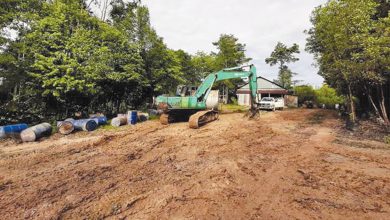Stop Killing a Major Tourist Attraction
By Mariam Mokhtar
As any keen birdwatcher will tell you, the Kuala Gula Bird Sanctuary, which was established by the Wildlife and National Parks in 1970, is a renowned haven for birds. It is situated in the Matang Forest Reserve, in Kerian district and was formed to protect migratory and resident species of birds. Experts believe that from August to April each year, about 200,000 migratory birds, from around 50 species, stop over at the Kuala Gula wetlands, to avoid the cold winter months in temperate regions. The birds have flown in from Japan in the east, from as far north as Siberia in Russia and also from Kazakhstan, in central Asia.
The Kuala Gula Bird Sanctuary is in the mangrove swamp forest and is important not just because of its tourist potential, but because it is a source of livelihood for the families of the 600 fishermen in the area, who depend on the mangrove forests and marine ecosystem.
The Matang Mangrove Forest, which comprises around 40,000 hectares, is the largest mangrove ecosystem in Semenanjung Malaysia. It is popular with both local and foreign tourists. The villagers derive an invaluable side-income from boat hire, homestays, restaurants, handicrafts, guided tours and tours to see cage culture farms, traditional fishermen, charcoal making, cockle culture and shrimp paste processing factories.
Visitor centres cater for the needs of tourists and make locals aware that protecting the ecosystem of the mangrove forest guarantees their economic survival too.
In early February, land clearing activities close to Kampung Kuala Gula, alarmed the local community. According to the Friends of Mangroves (FoM) chairman Zakaria Mohamed, 6ha of mangrove forest had been cleared for the construction of a shrimp farm. He said, “What upsets us the most is seeing our efforts to rehabilitate the mangrove swamps go down the drain.” Zakaria was referring to the efforts of the local community to regenerate the area, after the damage caused to the mangrove coastal shoreline by the 2004 Indian Ocean tsunami.
In the aftermath of the tsunami, villagers realised the importance of the tidal zones in minimising the impact of the full force of the tsunami and in preventing localised flooding. A combined effort initiated by local NGOs, government agencies, schools, universities, corporations and the local community, mobilised the planting of 200,000 mangrove trees. It had been ongoing for the past seven years.
A month after the first report about land clearing activities in Kuala Gula, the Perak Forestry Department announced that it would submit a proposal to the state government recommending that a 1500ha tract of mangrove forest, in Kampung Teluk Rubiah, in Kuala Gula be earmarked as a forest reserve.
The pengarah of the Forestry department, Roslan Ariffin said, “The Kuala Gula forest is one of the feeding grounds for migratory birds that travel between the northern and southern hemispheres during winter months.”
“These forests also act as a natural barrier to storm surges and tsunamis. It is imperative that we make an effort to protect them.”
For those who claim that the Kuala Gula sanctuary is just a muddy slough where nothing much happens, perhaps, the following activities can alter their minds.
Some of the species which birdwatchers find most interesting are the purple herons, the eagles and the woodpeckers. Nestling in the branches of the trees along the riverbanks are scores of other varieties of birds. Anyone who is keen on wildlife will notice that the riverbanks are teeming with monitor lizards, snakes and insects. Local fishermen say that there are crocodiles in the water and occasionally, dolphins are known to stray into the estuary. The mudflats are teeming with life from crabs, to freshwater prawns which inhabit the mud, and mudskippers which are always fascinating to watch, as they propel themselves, using their fins as legs.
Visitors also find trips to the cockle farms popular. They observe how cockles are cleaned by placing them in a rotating screen which removes the mud from their shells. The cleaned cockles are packed into nylon bags before being sent to the wholesalers. Tours to cage culture farms are also popular and for the more adventurous, fishing trips can also be arranged with local fishermen.
No trip to this important fishing estuary is complete without sampling some of the seafood fresh from the area. Many places cater for visitors and some restaurants have built an enviable reputation. So, you will have to dine early if you wish to secure a seat.
If we destroy Kuala Gula, we are killing the goose that lays the golden eggs.


